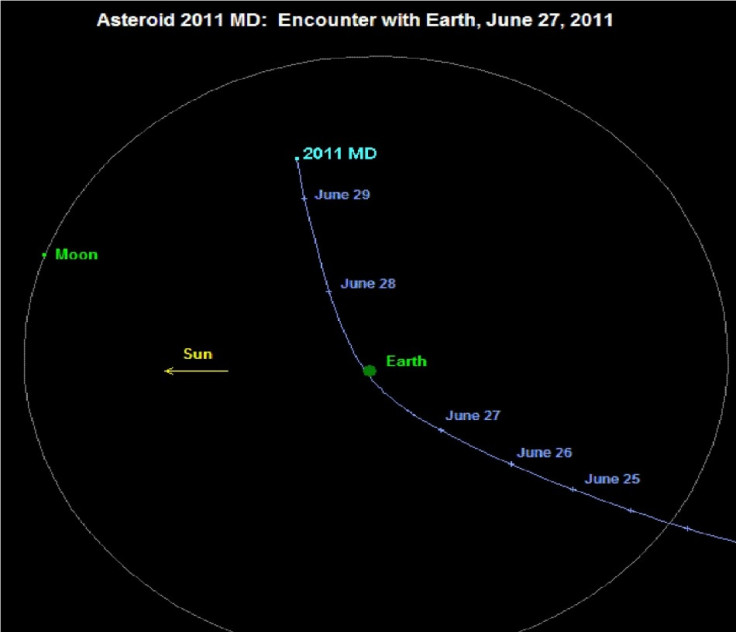House-size asteroid 2011 MD will fly dangerously close to Earth's surface Monday

An asteroid, the size of a house, will come dangerously close to the Earth's atmosphere but will zoom by harmlessly on Monday, astronomers said.
The orbit of the asteroid, named 2011 MD, is uncannily similar to Earth's orbit and the space rock, which is about 20 feet to 50 feet across, will come very close to Earth's surface - about 7,500 miles - but will not enter the Earth's atmosphere.
2011 MD will fly by our planet without harming it. However, it will give off a light bright enough that can be seen through a small telescope (8-inch or larger). The next time 2011 MD will greet Earth is around 2022 but that time too it will not enter Earth's atmosphere.
2011 MD poses no danger to Earth and even if it did hurtle towards Earth's surface, there's nothing to be afraid of, Astronomy Now magazine's Dr. Emily Baldwin said in an interview with Skymania news.
"We are certain that it will miss us, but if it did enter the atmosphere, an asteroid this size would mostly burn up in a brilliant fireball, possibly scattering a few meteorites," Baldwin said.
Scientists said 2011 MD will enter the orbits of several communications and spy satellites but is not expected to damage them. The International Space Station will also be some 7,000 miles away from the asteroid's flight path, they said.
Agrees Spaceweather.com. "As the asteroid recedes from Earth, it will pass through the zone of geosynchronous satellites. The chances of a collision with a satellite or manmade space junk are extremely small, albeit not zero," the website said.
However, the encounter is close enough for Earth's gravity to "sharply alter the asteroid's trajectory," it added.
The space rock was first sighted on June 22 by LINEAR (the Lincoln Near-Earth Research project), which employs a robotic telescope in New Mexico. The next day an alert was put out by the International Astronomical Union's Minor Planet Center in Massachusetts.
When the asteroid will fly past Earth, it will be daytime in the UK but sky-gazers in other parts of the world, such as in South America, will be able to catch a glimpse of the space rock as it hurtles through a star field.
According to Minor Planet Center's ranking charts 2011 MD will be the fifth-closest asteroid to graze past Earth. In the past, three asteroids have zoomed past Earth at a closer distance, including a tiny asteroid (2011 CQ1) which flew by on February 4 this year after coming as close as 3,400 miles away from Earth's surface. The fourth, an asteroid named 2008 TC3 had entered Earth's atmosphere on October 7, 2008, but disintegrated into tiny pieces at a height of around 23 miles off the ground.
On November 8, an asteroid called 2005 YU55, measuring around 1,200 feet across and weighing 50 million tons, is expected to fly inside the orbit of the moon.
NASA scientists say the Earth is surrounded by 8,099-odd known asteroids or Near-Earth Objects (NEO) of different sizes, whose orbits are dangerously close to the Earth's surface. Of them, only around 1,000 measure less than 100 feet across, about 827 are asteroids with a diameter of half a mile or longer and about 1236 of them have been classified as Potentially Hazardous Asteroids.
In 2016, NASA will launch the OSIRIS-Rex asteroid probe that will visit a potentially dangerous NEO called 1999 RQ36 in 2020. 1999 RQ36 is 1,900 feet wide and scientists say it has a 1-in-1,800 chance of hitting Earth in the year 2170, and a 1-in-1,000 chance of crashing into us in 2182.
As for asteroids the size of 2011 MD, NASA said asteroids of this size come this close to Earth once in every six years on average.
Must read: 2011 MD asteroid: When and from where will the giant space rock be visible Monday?
© Copyright IBTimes 2025. All rights reserved.





















